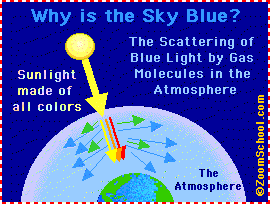 Sunlight is made up of all the colors of the rainbow: red, orange, yellow, green, blue, and violet. The gas molecules in the atmosphere interact with the sunlight before the light reaches our eyes.
Sunlight is made up of all the colors of the rainbow: red, orange, yellow, green, blue, and violet. The gas molecules in the atmosphere interact with the sunlight before the light reaches our eyes.
The gas molecules in the atmosphere scatter the higher-energy (high frequency) blue portion of the sunlight more than they scatter the lower-energy red portion of the sunlight (this is called Rayleigh scattering, named for the physicist Lord John Rayleigh). The Sun appears reddish-yellow and the sky surrounding the Sun is colored by the scattered blue waves.
When the Sun is lower in the horizon (near sunrise or sunset), the sunlight must travel through a greater thickness of atmosphere than it does when it is overhead, and even more light is scattered (not just blue, but also green, yellow, and orange) before the light reaches your eyes. This makes the sun look much redder.
Caution
Never stare directly at the Sun.
